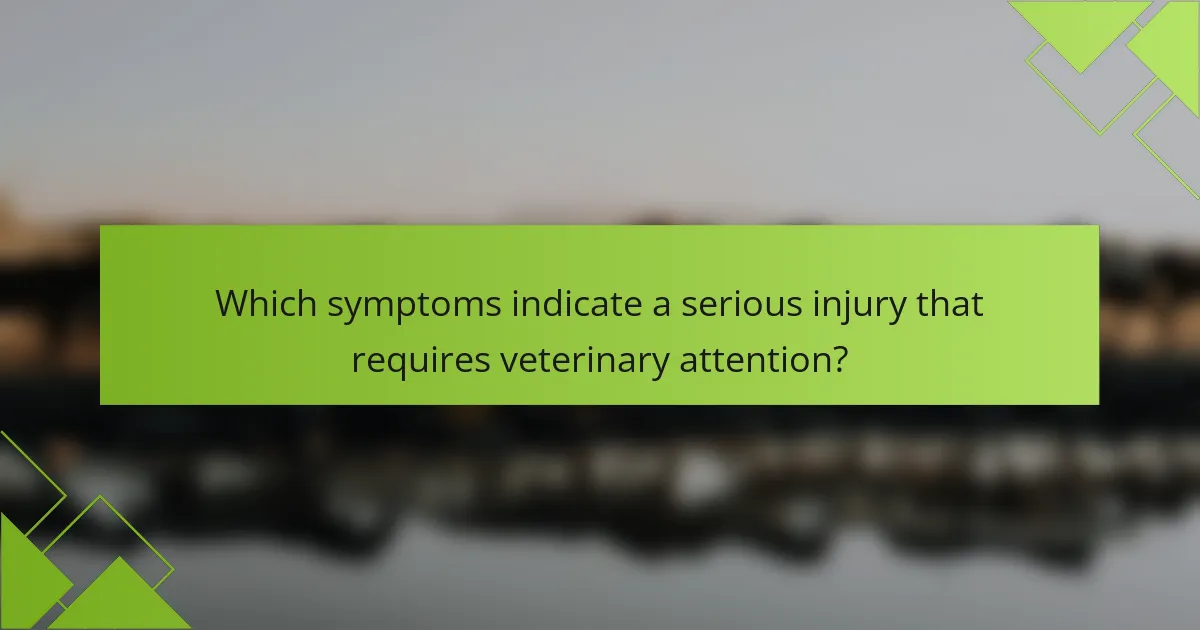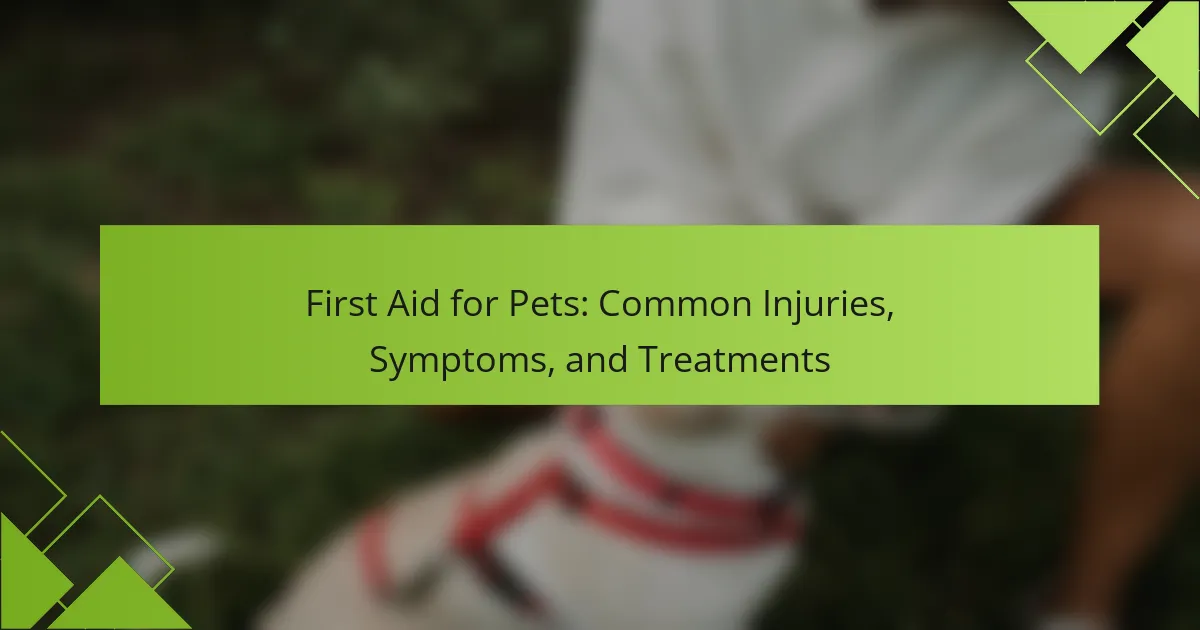Knowing first aid for pets can save their lives during emergencies. Common injuries include cuts, bites, fractures, and poisoning. Recognizing symptoms is crucial for effective treatment. This article covers immediate first aid steps, symptoms requiring veterinary attention, and unique considerations for exotic pets.

What are the common pet injuries that require first aid?
Common pet injuries that require first aid include cuts, bites, fractures, and poisoning. Recognizing symptoms early is crucial for effective treatment. Cuts may bleed and cause pain, while bites can lead to infection. Fractures often result in limping or inability to use a limb. Poisoning symptoms vary but can include vomiting, diarrhea, or lethargy. Immediate first aid can stabilize the pet until veterinary care is available.
How can pet owners identify signs of injury in their pets?
Pet owners can identify signs of injury in their pets by observing changes in behavior, mobility, and physical appearance. Look for limping, reluctance to move, excessive vocalization, or hiding. Additionally, check for swelling, bleeding, or unusual posture. Prompt recognition aids in timely treatment.
Which types of injuries are most prevalent in pets?
Common injuries in pets include fractures, cuts, and sprains. These injuries often arise from accidents, falls, or fights. Fractures typically cause severe pain and swelling, while cuts may lead to bleeding or infection. Sprains result in limping and discomfort. Immediate first aid is crucial for effective treatment.

What are the immediate first aid steps for treating pet injuries?
To treat pet injuries, follow these immediate first aid steps: assess the situation, control bleeding, clean the wound, and seek veterinary care.
1. Assess the situation: Ensure your safety and evaluate the pet’s condition.
2. Control bleeding: Apply pressure with a clean cloth or bandage.
3. Clean the wound: Rinse with clean water and apply an antiseptic.
4. Seek veterinary care: Contact a veterinarian for further treatment.
How does the first aid approach differ between dogs and cats?
First aid for dogs and cats differs primarily in their physiological responses and behaviors during emergencies. Dogs typically respond better to verbal commands, while cats may require a more cautious approach due to their instinctive fear responses.
For example, when treating wounds, dogs may tolerate handling better, allowing for easier bandaging. In contrast, cats often need to be restrained gently to prevent injury to themselves or the caregiver.
Additionally, certain first aid techniques, like administering CPR, vary significantly between species due to differences in anatomy. Understanding these distinctions ensures effective and safe first aid for both dogs and cats.
What tools and supplies are essential for a pet first aid kit?
A pet first aid kit should include essential tools and supplies to address common injuries and symptoms. Key items are adhesive bandages, antiseptic wipes, gauze pads, scissors, tweezers, and a digital thermometer.
| Item | Purpose |
|———————|————————————-|
| Adhesive bandages | Protects minor cuts and scrapes |
| Antiseptic wipes | Cleans wounds to prevent infection |
| Gauze pads | Absorbs blood and covers larger wounds|
| Scissors | Cuts tape, gauze, or clothing |
| Tweezers | Removes splinters or foreign objects |
| Digital thermometer | Checks for fever in pets |

Which symptoms indicate a serious injury that requires veterinary attention?
Symptoms indicating a serious injury that requires veterinary attention include severe bleeding, difficulty breathing, inability to stand, persistent vomiting, seizures, and signs of pain. Immediate veterinary care is crucial in these situations to ensure the pet’s well-being.
How can pet owners assess the severity of their pet’s condition?
Pet owners can assess the severity of their pet’s condition by observing symptoms and behavior changes. Look for signs such as difficulty breathing, excessive bleeding, or inability to move.
Evaluate the duration and intensity of symptoms. For instance, persistent vomiting or diarrhea may indicate a serious issue.
In addition, consider the pet’s history and any recent injuries. If a pet shows signs of distress or pain, seek veterinary assistance promptly.
Using a pet first aid guide can help identify critical symptoms and appropriate responses.

What are the specific treatments for common pet injuries?
Common pet injuries include cuts, sprains, fractures, and bites. Treatments vary by injury type. For cuts, clean the wound and apply antiseptic. Sprains require rest and ice. Fractures need immobilization and veterinary care. Bites should be cleaned and assessed for infection. Always consult a veterinarian for proper diagnosis and treatment.
How to treat cuts and abrasions on pets?
Treat cuts and abrasions on pets by cleaning the wound, applying antiseptic, and covering it with a bandage. Start by gently washing the area with lukewarm water and mild soap to remove dirt. After cleaning, apply a pet-safe antiseptic to prevent infection. If the cut is deep or bleeding heavily, seek veterinary assistance. Monitor the wound for signs of infection, such as redness or swelling. Change the bandage regularly to keep the area clean and dry.
What are the steps for managing sprains and fractures in pets?
To manage sprains and fractures in pets, follow these essential steps: assess the injury, immobilize the affected area, apply cold compresses, and seek veterinary care.
First, check your pet for visible signs of injury and observe their behavior for pain or discomfort. If you suspect a sprain or fracture, gently immobilize the affected limb using a splint or bandage. Apply a cold compress to reduce swelling, ensuring it does not touch the skin directly to avoid frostbite. Finally, take your pet to a veterinarian for a thorough examination and appropriate treatment.
How should pet owners handle allergic reactions in their pets?
Pet owners should act quickly if their pets show signs of allergic reactions. First, identify the allergen and remove it if possible. Monitor symptoms like swelling, itching, or difficulty breathing. If severe, administer an antihistamine as directed by a veterinarian. Seek immediate veterinary care for any serious reactions to ensure proper treatment and recovery.

What are the unique challenges of providing first aid to exotic pets?
Providing first aid to exotic pets presents unique challenges due to their varied anatomy, behavior, and specific needs. Unlike common pets, exotic animals may require specialized knowledge to address their injuries effectively.
Exotic pets often exhibit stress responses that complicate treatment. For example, reptiles may become immobile when frightened, making it difficult to assess injuries. Additionally, many exotic species have specific dietary and environmental requirements that must be considered during treatment.
Limited access to veterinary care for exotic pets can exacerbate challenges. Not all veterinarians have the expertise needed for species-specific first aid, leading to potential delays in treatment.
Finally, the legal and ethical considerations surrounding exotic pet ownership can influence the approach to first aid. Different regulations may apply, affecting how care is provided and who is authorized to administer it.
How do first aid protocols vary for different species?
First aid protocols differ significantly among species due to variations in anatomy, physiology, and common injuries. For instance, dogs and cats may require different techniques for CPR, while reptiles have unique needs for temperature regulation during treatment. Understanding these differences is crucial for effective care.

What are the rare but critical first aid scenarios for pets?
Rare but critical first aid scenarios for pets include severe allergic reactions, heatstroke, choking, poisoning, and traumatic injuries. Each situation demands immediate attention and specific interventions.
Severe allergic reactions can occur from insect stings or food allergies, leading to anaphylaxis. Heatstroke is common in hot weather, requiring rapid cooling methods. Choking can obstruct airways, necessitating the Heimlich maneuver for pets. Poisoning from household substances or plants is urgent, often needing veterinary assistance. Traumatic injuries from accidents or falls may involve fractures or bleeding, requiring stabilization and transport to a vet.
Recognizing these rare scenarios is vital for effective first aid and ensuring pet safety.
How to respond to poisoning or toxic exposure in pets?
If a pet is poisoned or exposed to toxins, act quickly. First, contact a veterinarian or poison control. Remove the pet from the source of exposure. If the substance is known, provide details to the vet. Do not induce vomiting unless instructed. Keep the pet calm and monitor for symptoms like lethargy, vomiting, or seizures. Immediate professional help is crucial for the best outcome.
What should pet owners do in case of heatstroke or hypothermia?
In case of heatstroke or hypothermia, pet owners should act quickly to stabilize their pet’s condition. For heatstroke, move the pet to a cool area, offer water, and apply cool, wet cloths to their body. For hypothermia, bring the pet indoors, wrap them in warm blankets, and provide warm water. Monitor their temperature and seek veterinary care immediately if symptoms persist.

How can pet owners prepare for emergencies related to their pets?
Pet owners can prepare for emergencies by creating a comprehensive first aid kit for their pets. Essential items include bandages, antiseptic wipes, tweezers, and a digital thermometer. Familiarize yourself with common pet injuries and symptoms, such as cuts, burns, or poisoning. Knowing basic treatment methods, like applying pressure to a wound or inducing vomiting safely, can be crucial. Regularly update your kit and stay informed about pet first aid through courses or resources.
What preventive measures can reduce the risk of injuries in pets?
Preventive measures to reduce the risk of injuries in pets include regular veterinary check-ups, proper training, and safe environments. Keeping hazardous items out of reach and using pet-proofing techniques can significantly lower injury risks. Additionally, providing appropriate toys and monitoring playtime helps prevent accidents.
Which resources or training programs are recommended for pet first aid?
For effective pet first aid training, consider programs from the American Red Cross, PetTech, and the National Association of Professional Pet Sitters. These resources offer comprehensive courses covering injuries, symptoms, and treatments. Training typically includes hands-on practice, emphasizing critical skills like CPR and wound care.
What are the best practices for maintaining a pet first aid kit?
To maintain a pet first aid kit effectively, regularly check and replenish supplies. Include essential items like antiseptic wipes, bandages, and tweezers. Store the kit in a cool, dry place and ensure all family members know its location. Review expiration dates on medications periodically and replace expired items promptly.
What common mistakes should pet owners avoid when administering first aid?
Pet owners should avoid common mistakes like panicking, which can escalate the situation. Failing to assess the injury properly can lead to incorrect treatment. Not having a first aid kit ready is another critical oversight. Additionally, administering human medications can harm pets. Ignoring the need for professional veterinary care after initial first aid is a significant error. Lastly, not practicing first aid techniques can result in ineffective responses during emergencies.
